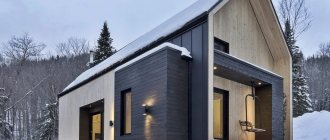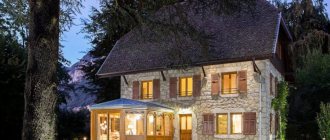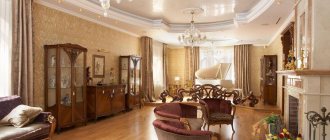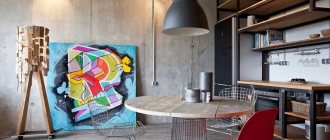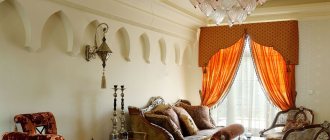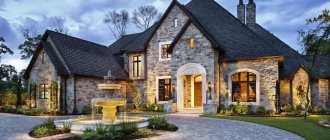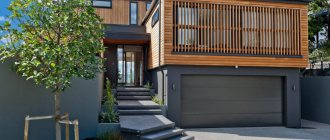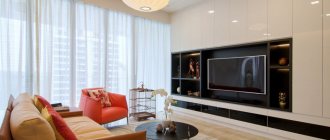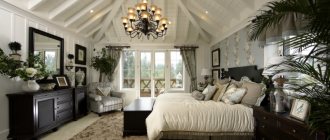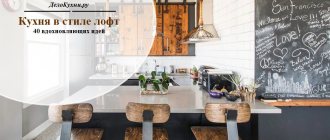Victorian style house. Sounds royal, don't you think? Yes, but this is not a palace. Although from the outside the house looks high-status and reliable. And the Victorian era fell on the age of industrialization, in the second half of the 19th century. And the name of the direction in architecture and interior design was given by Queen Victoria, who ruled during this period.
Victorian houses were owned by the famous and wealthy bourgeoisie. But it was precisely thanks to industrialization and mass production that such houses became available to ordinary people. And even though it was an imitation of the bourgeois, that is, the real Victorian style, and the size of the houses was compact, the conventions were respected.
Externally, even frame houses in this style looked beautiful and expensive. This, of course, warmed the souls of ordinary people, and the bourgeoisie reproachfully called such dwellings “counterfeits.”
If you watched the series “All the Women Are Witches” about three witch sisters, then you remember their family nest. This is an example of the style that we will tell you about now.
Architectural features of a Victorian house
A Victorian house design, like a 10x10 one-story house design, must take into account certain features that are common to such buildings.
These features are:
- Juicy, but not harsh colors for finishing the facade and roof.
- Roof tiles.
- Various materials for facade finishing from brick and plaster to siding.
- The roof itself is broken and multi-stage.
- There is a large variety of varied decor on the façade.
- Narrow windows with and without shutters, dormer windows on the roof, serving more as decoration than as an opening to the world.
- Large windows, including panoramic ones.
- Porch and obligatory terrace at the entrance.
- Columns supporting the roof of the terrace.
- Balconies with columns, ledges with a window, turrets under a gabled roof.
One gets the feeling that there was a house and new rooms were gradually added to it, which eventually formed such a complex volume.
If you are planning a compact house, the complex volume can be sacrificed. But there must definitely be a terrace with columns, windows of different sizes and different shapes. And by choosing rich but light colors for decoration, you can visually increase the size of the house.
The task of the owner of a Victorian house was to stand out, show his taste, demonstrate education (not everyone can dream up a project), and wealth. Since people with the same idea of the project and plan do not theoretically exist, it is very problematic to meet two houses that are identical in appearance and architecture. The interiors may be somewhat similar - remember about the mass production of household items?
LiveInternetLiveInternet
Victorian architecture styles:
Neo-Gothic Victorian
The neo-Gothic Victorian (Neogotic Victorian, 1840-1880) style of architecture drew its inspiration mainly from Western Europe, reinterpreting medieval forms through its own example.
It was European castles that were the prototypes for such houses, which most often had asymmetrical facades, textured walls and steep roof slopes.
The neo-Gothic Victorian style in architecture is most often easily identified by decorative elements under the gables ("vergeboard", carved wood or patterned metal), as well as very elongated vertical windows.
Italian style
The Italianate style (Italianate, 1840-1885) is a mixed style, as it contains features of both Victorian architecture and the Federal style.
It makes frequent use of arches and Roman pediments, and the intricate detailing of many of the decorative elements of the exterior is entirely Italian in style.
Particular attention is paid to decorative cornices, arched windows and porch decoration. Some Italian houses have a square plow or dome, but most have a flat or low-pitched roof.
In addition to private construction, the Italian Victorian style is common in public buildings of the 1800s in the United States.
Second Empire style
As soon as the United States began to prosper, a new one was born from the Victorian style - the Second Empire (Seond Empire, 1855-1885). The impetus for the construction of more luxurious, expensive and spacious buildings was the booming economy of the country. This style is inspired by the architecture of Paris, and most often Second Empire style buildings have flat facades topped with windowed mansards.
The porch is decorated with double entrance doors, and bay windows of various sizes are also very common.
Eastlake Style
The Eastlake (1860-1890) or Stick style became especially popular in wooded areas where wood was much cheaper.
Houses in this style are half frame; their roofs usually have steep slopes with simple gables. The Eastlake style is especially common in California, as well as in the southeastern United States.
Shingle (Shingle, 1880-1900) is characterized by the fact that houses in this style have wooden shingles, both in the construction of the roof and in the decoration of external walls (like siding). In Shingle houses, sometimes the entire facade of the building is decorated with flexible tiles.
Folk Victorian style
Folk Victorian emerged from an old American tradition that flourished among working-class immigrant families.
It consisted of the family personally building their own (often the first in the United States) house on newly purchased land. Most often, houses of this style are found in rural areas and are built from local materials.
The decorative and applied design of the exterior, porch, and front door in folk houses is most often taken very seriously and with a creative approach.
Queen Anne style
One of the most recognizable Victorian styles, Queen Anne (1880-1910), experienced a heyday in popularity from the late 1870s to the early 1900s. The style was greatly influenced by the work of the British architect Richard Norman Shaw, who maintained the idealistic image of the Old English cottage with an unbridled decorative impulse throughout the years of his work.
Queen Anne style homes often have irregular floor plans (different for different floors), complex steep roof structures, and elaborate decorative gables.
Tall windows, bay windows, octagonal or round towers are also often present in this style. In such houses there are absolutely no rules for painting the exterior, so they can be any color.
source
Interior decoration
A Victorian house plan has many rooms flowing into one another. We present several of them.
The dimensions indicated on the plan can be varied at your discretion, but there should be enough space in the house for everyone.
- From the entrance you immediately find yourself in a spacious, bright hall with a high ceiling or living room.
- There are no corridors or minimal ones. But there may be walk-through rooms.
- There are bay windows in the living room and other rooms (they look like ledges from the outside).
- There are many technical rooms and corners, such as a boiler room, pantry, built-in wardrobes, laundry rooms.
- There may be several bathrooms, but they are all small in area.
- The hall, living room, dining room and kitchen are amazing in size, which cannot be said about the guest and bedroom rooms.
- There is a fireplace in the living room - in houses whose owners could afford it.
- The walls may not form a right angle, but go at an angle of 45 degrees.
A modern adaptation of the style can also fit a garage into the project.
Short story
As its name suggests, the Victorian style reflects the architectural styles that were in vogue during the reign of the famous Queen Victoria (1837-1901). Many people don't even know that some of the details that we know are associated with this style are actually closely related to other older movements, such as medieval Gothic and Romanesque. Due to the greatness of the British Empire, national architecture took strong roots throughout the world. Similar buildings can be found in the following countries:
- North America;
- Italy;
- New Zealand;
- Australia.
Victorian house status
Since the main task of the residents of such a house was to demonstrate their status (at least externally), the lifestyle had to correspond to this intention.
- The interior decoration of the house is rich and luxurious, so that there is something to show to guests.
- And the guests were often and in large numbers. After all, parties were held frequently in the Victorian era. That's the explanation for the spacious living and dining rooms. And in a spacious kitchen it’s easier to prepare dinner for a horde of hungry guests.
- Lunch is an indispensable component of such receptions. The guests, full of delicious dishes, were clearly in a positive mood to evaluate both the hosts and the atmosphere.
- The discrepancy between small latrines, bedrooms and spacious living rooms and dining rooms forced people to decorate everything they could - from the facades of the house to the wall above the fireplace (to hide the empty space). The echo was literally drowned in all this splendor.
Those who like free space, who prefer not to clutter their home with unnecessary, non-functional things, will not like the Victorian style. Although…
Characteristic features of the style
“Fear of empty space”: decorations, furniture and plants completely filled the rooms
Abundance of ornamentation on the walls, ceiling and upholstery
Paintings in massive carved frames and tapestries
Rich drapery: dense, dark curtains made of velvet and corduroy
Collections of ashtrays, photographs, porcelain figurines and busts
Fireplace as an essential element of English decor
The heart of a Victorian home is the fireplace. Decorated with natural stone and wood, decorated with carvings, matching the color of the furniture and wall upholstery.
Or it could stand out with an unusual color scheme or catchy design. Such fireplaces attracted attention.
Floor decoration
The floor was covered with parquet in the era of Queen Victoria.
Or tiles, if you wanted to embody the colonial exoticism of the East Indies in the mansion. Tiles were usually installed in hallways, bathrooms and kitchens.
Carpets of light colors with floral patterns were very popular.

